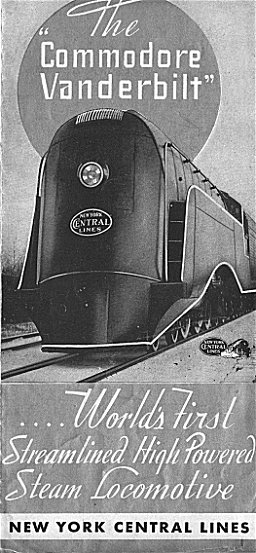In 1934, Chrysler Motor Car Company introduced the "airflow" design, inaugurating the era of streamlining in transportation. Carl F. Kantola, a longtime New York Central employee, proposed a streamlined steam locomotive and his design was accepted by corporate officials. Hudson No. 5344 of class J-1e, built by ALCo in 1931, was undergoing repairs in the West Albany shops and was selected to receive the streamlining treatment. Kantola's design was modified by the Case Institute of Technology. In late December of 1934, No. 5344 appeared in its new form as the Commodore Vanderbilt, named for the founder of the New York Central. After a public relations tour of the NYC system, she was assigned to haul the Twentieth Century Limited between Chicago and Toledo. Movie cuts of her in that role appear on the Chicory Productions video The Century of the New York Central, Part I.
The New York Central issued a publicity leaflet introducing the Commodore Vanderbilt as "the world's first streamlined high-powered steam locomotive." The leaflet claimed that the streamlining could decrease head air resistance by as much as 36 percent at speeds of 70 to 90 miles per hour, with a corresponding saving in fuel. It is not known whether this claim was verified by testing, and the extra weight of the streamlined shrouding (probably about six tons) may have reduced any such savings. Nevertheless No. 5344 made history as the first steam engine with the simplified lines of the "upside down bathtub" style of streamlining, and became the prototype for countless electric or wind-up toy trains sold by Marx and other manufacturers into the post-World War II era.
In 1939, No. 5344 was re-streamlined with Henry Dreyfuss's "bullet nose" design that had been introduced with the J-3a class of 1938. In this guise she differed in dimensions from other J-1e Hudsons, having 23¾x28-inch cylinders and a boiler pressure of 250 pounds. Her tractive effort was 42,480 pounds, with the booster adding 12,100 pounds, and she weighed 370,000 pounds. She lost her streamlining in 1945 and was scrapped in 1954.
My father's collection of railroadiana included a copy of the Commodore Vanderbilt publicity leaflet. To view the outside and inside pages, click the links below. A 1937 photo from the Gary Overfield collection on George Elwood's NYC Steam Photos site shows the disc drivers and roller bearing side rods that were applied in 1935.
